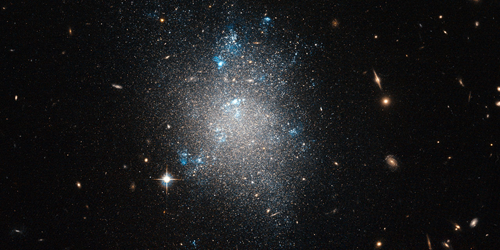Dwarf Galaxies Size Up Dark Matter Models
Dwarf galaxies are a thorn in the side of cosmologists, as their central regions don’t match predictions from the cold dark matter (CDM) model that is considered standard. Theorists have proposed explanations involving either the effects of supernovae or a modification of the CDM model, but both solutions have lacked empirical support. A new study suggests a way to discriminate between them by measuring the distribution of stars in the centers of dwarf galaxies [1].
The CDM model predicts that all galaxies should have a “cusp”—a sharp density peak at the galactic center. However, some dwarf galaxies have a uniform-density “core” in their central regions. Astrophysicists usually explain these cores with a supernova-feedback model, in which strong winds from stellar explosions push matter out of the center. However, another possibility is that dark-matter particles scatter off each other, smoothing out the dense regions (see Synopsis: Self-Interacting Dark Matter Scores Again). Such interactions would have consequences for efforts to detect dark matter.
To distinguish between models, Jan Burger from the Max Planck Institute for Astrophysics in Germany and colleagues explored potential astronomical signatures of supernova feedback. They ran detailed computer simulations of a dwarf galaxy experiencing sudden bursts of star formation—a necessary ingredient to produce sufficiently strong winds. In plots of velocity vs distance, they found that stars of similar age and composition clustered in shells. “Finding such signatures would eliminate the need for extensions of the CDM model,” Burger says. Current telescopes would have difficulty spotting the shells, but the team expects that the Nancy Grace Roman Space Telescope (currently scheduled for a mid-2020s launch) could potentially test whether any nearby dwarves host star-packed shells.
–Michael Schirber
Michael Schirber is a Corresponding Editor for Physics Magazine based in Lyon, France.
References
- J. D. Burger et al., “Kinematic signatures of impulsive supernova feedback in dwarf galaxies,” Phys. Rev. Lett. 129, 191103 (2022).




